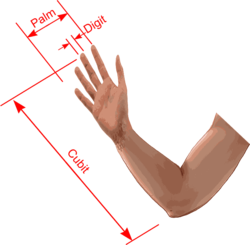Early Egyptian Measurements
From DT Online
Introduction
Measurement and Surveying was important in Ancient Egypt because the annual floods buried or destroyed boundary markers, which then had to be re-established to check ownership of the fields.
The Egyptians are thought to have developed the Cubit. This measurement was used by many ancient peoples and in the Middle Ages. It is taken to be the length from the bent elbow to the tips of the fingers – a distance of approximately 18 inches or 450mm. The actual measurement would vary from person to person and so standard Cubit length rods were made and placed in Temples where they could be accessed for reference.
Cubit Rod
Cubit Rods were made from wood, slate or stone, some with markings to show sub-divisions. The Egyptian Royal Cubit’’’ was divided into 7 [1]. A Palm was based on the width of the palm of the hand.
Palm
Palms were further divided into 4 [2] based on the width of the human fingers which was a common unit of measurement in ancient times. So four Digits equal one Palm and seven Palms equal one Cubit - the wooden Cubit Rod, one Cubit long, was marked in Palm and Digit divisions and used by Architects and Surveyors as we now use our modern Rules.
Cord
It is probable that for convenience, there were also Rods made which were several Cubits long and for surveying purposes, Egyptians used a knotted rope or Cord of 100 Cubits length. Ancient Egyptian surveyors were known as Harpedonapata or rope-stretchers and a length of rope longer than 100 Cubits may have been too difficult to pull tight when measuring.


